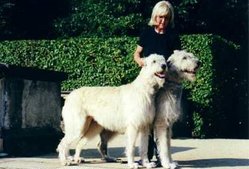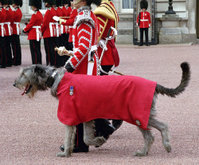
|
From Wikipedia the free encyclopedia, by MultiMedia |
| Irish Wolfhound | ||
|---|---|---|

A pair of Irish Wolfhounds
|
||
| Alternative names | ||
| Country of origin | ||
| Ireland | ||
| Common nicknames | ||
| Classification and breed standards | ||
| FCI: | Group 10 Section 2 #160 | |
| AKC: | Hound | |
| ANKC: | Group 4 (Hound) | |
| CKC: | Group 2 (Hound) | |
| KC (UK): | Hound | |
| NZKC: | Hound | |
| UKC: | Sighthounds and Pariah Dogs | |
| Not recognized by any major kennel club | ||
| This breed of Dog is extinct | ||
| Notes | ||
The Irish Wolfhound is a breed of hound (a sighthound), bred to hunt. The name originates from its purpose rather than from its appearance: To hunt wolves.
These Dogs are the tallest breed, with a swift pace and good sight. They have a rough coat (gray, brindle, red, black, pure white, or fawn), a large arrow-shaped head, and a long, muscular neck.
The Irish Wolfhound is usually known as the tallest Dog in the world, averaging up to 86 cm (34 inches) at the withers, a fact that sometimes is its biggest disadvantage when attracting owners who have no concern for its special needs. As with all breeds, the ideal and accepted measurements vary somewhat from one standard to another, and there will always be individuals whose size falls outside these standards. However, generally breeders aim for a height averaging 32 to 34 inches (81 cm to 86 cm) in male Dogs, two to four inches (5 to 10 cm) less for bitches. Acceptable weight minimums range from 105 lb (48 kg) for bitches to 120 lb (54 kg) for males.
In temperament, they are considered gentle and friendly, very calm in the house, enjoying long sleeps but energetic when taken for walks. Despite their great size and sometimes intimidating appearance, wolfhounds are sensitive and should be corrected firmly but without anger. They should be socialized from a young age so that they have a chance to gather experience. While historically Wolfhounds should show a strong guarding instinct, most modern Irish Wolfhounds are not temperamentally suited to be a guard Dog.
 Irish Guards mascot in parade dress
Irish Guards mascot in parade dress
Wolfhounds should not receive additional supplements when a good Dog chow is used. It is generally accepted that they should be fed a large breed puppy food until 18 months of age and then change to a large breed adult food.
By the age of 8 months, the Dogs appear adult, and many owners start stressing them too much. Outstretched limbs and irreparable damage are the result. Wolfhounds need at least 18 months to be ready for lure coursing, running as a sport, and other strenuous activities.
Heart disease and bone cancer are the leading cause of death and like all deep-chested Dogs, gastric torsion (bloat) is always a possibility. Otherwise they are generally a healthy Dog with few if any breed specific illnesses. The average lifespan is around 6 to 7 years, though breeders are doing their best to increase this, with some animals now reaching 10 years or more.
The breed is very old, possibly from the 1st century BC or earlier, bred as war Dogs by the ancient Celts, who called them Cú Faoil. The Irish continued to breed them for this purpose, as well as to guard their homes and protect their stock. Regular references of Irish Wolfhounds being used in Dog fights are found in many historical sagas - Cuchulain's favourite, Luath was slain by a southern chief's hound, Phorp.
While many modern texts state Irish wolfhounds were used for coursing deer, contemporary pre-revival accounts such as Animated Nature (1796) by Oliver Goldsmith are explicit that the original animal was a very poor coursing Dog. Their astonishing size, speed, and intelligence made them ideal hunting animals for both wild boar and wolves, and many were exported for this purpose. They were perhaps too ideal, as the wolf is now extinct in Ireland. The Irish Wolfhound has been recorded as being exhibited in Ancient Rome to some excitement, and mention is made that they so amazed and terrified the Romans that it was seen fit to only transport them in cages. There exists stories that in the arena, the original Wolfhound was the equal of a lion.
During times of conflict with England, it was not uncommon for Wolfhounds to be trained to take armored knights off of their horses. Thus allowing an infantry man to move in and finish the kill if the Wolfhound has not done so already.
Due to a massive export into various countries as a gift for royalty and a ban that allowed only royalty to own such a Dog, the breed almost vanished in the middle of the 19th century. Captain Graham rebred the Irish Wolfhound with the Deerhound, Great Dane, Borzoi and other breeds; this saved the breed, but had the inevitable effect of altering its appearance.
The ancient breed (often referred to as the Irish WolfDogge in contemporary accounts) was available in both a smooth and rough coated variety. Descriptions of its appearance and demeanor, as well as the method of its use place it closer to the flock guardians in appearance than the modern breed. The historical variety was famed for its loyalty, discernment, grave nature and aggression. In terms of temperament the modern breed has been greatly mellowed.
An Irish Wolfhound serves as the regimental mascot to the Irish Guards in England and accompanies the regiment in all of its parades.
The skulls of several Irish Wolfhounds were recovered in excavations of the ruins of Emain Macha. These skulls are now in the possession of the Royal Irish Academy. No reconstruction appears to have been done to establish the appearance of these progenitors of the breed.
The Irish Wolfhound is also the mascot for the London Irish Rugby team.
Dogs, made by MultiMedia | Free content and software
This guide is licensed under the GNU Free Documentation License. It uses material from the Wikipedia.